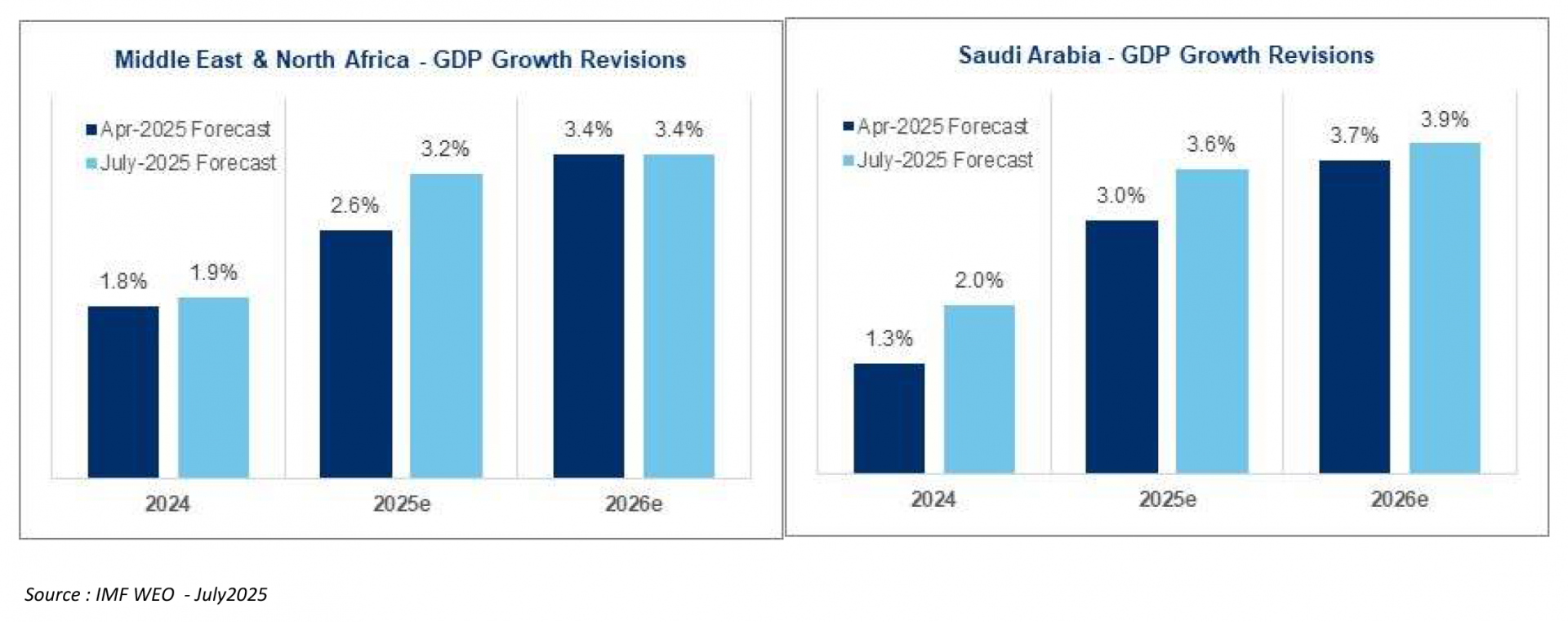2025-07-30
indicators

The International Monetary Fund (IMF) has raised its global growth forecasts for 2025 and 2026 in its July 2025 World Economic Outlook, projecting real GDP growth at 3.0% in 2025 and 3.1% in 2026. These represent upward revisions of 20 and 10 basis points, respectively, driven largely by preemptive trade activity ahead of anticipated tariff hikes and a favorable fiscal environment supported by a weaker US dollar. Despite these adjustments, the IMF notes that growth remains below the pre-pandemic average of 3.7%, underlining persistent structural challenges. The IMF expects global inflation to ease, with headline rates forecast at 4.2% in 2025 and 3.6% in 2026. However, inflation dynamics remain uneven. In the US, tariffs are expected to push inflation above the Federal Reserve’s 2% target, while in other advanced economies, inflationary pressures are expected to remain subdued or decline. Advanced economies are forecast to grow moderately, with the 2025 and 2026 projections both raised by 10 basis points to 1.5% and 1.6%, respectively. Notably, US GDP growth is projected to reach 1.9% in 2025 and 2.0% in 2026, reflecting looser financial conditions, legislative fiscal support, and reduced tariff levels compared to earlier expectations. Meanwhile, Euro area growth was adjusted to 1.0% for 2025 due to stronger-than-expected performance in Ireland, which contributed significantly through pharmaceutical exports. Japan’s outlook was slightly revised upward for 2025, but slightly down for 2026. Among emerging markets, China’s growth forecast saw a major upgrade, with real GDP growth now expected at 4.8% in 2025 and 4.2% in 2026, thanks to robust Q1 performance and a significant reduction in tariffs. For the broader Emerging Market and Developing Economies group, growth was revised to 4.1% in 2025 and 4.0% in 2026. The Middle East and North Africa region experienced one of the most notable upward revisions. Real GDP growth in the region is now expected at 3.2% in 2025, up 60 basis points from earlier projections, largely due to stronger forecasts for oil exporters like Saudi Arabia. The IMF anticipates the region will continue to recover in 2026 with growth reaching 3.4%. Saudi Arabia’s own forecast was upgraded to 3.6% for 2025, supported by plans to reverse OPEC+ production cuts. Other regional highlights include Sub-Saharan Africa, where growth is forecast to rise to 4.0% in 2025 and 4.3% in 2026. Latin America and the Caribbean are expected to experience slower growth at 2.2% in 2025, before rebounding to 2.4% the following year. In contrast, Emerging and Developing Europe faces a downward revision for 2025, with growth now expected at 1.8%, although it is projected to recover to 2.2% in 2026. Trade volumes surged in early 2025 due to front-loading in anticipation of new trade barriers but are expected to contract in the second half of the year. The IMF revised its global trade volume forecast upward for 2025 but lowered its 2026 projection. A weaker US dollar has compounded the tariff shock, boosting the US current account but adding to global economic uncertainty. Rising geopolitical risks, including conflicts in the Middle East and Ukraine, pose additional threats to trade routes and commodity markets, potentially driving up prices and complicating monetary policy decisions. Despite these headwinds, the IMF highlighted that credible trade agreements and coordinated reforms could provide a foundation for medium-term growth. Enhanced cooperation in trade, labor mobility, and regulatory reform could reduce uncertainty and support broader economic stability in the years ahead. Source: Kamco Invest

